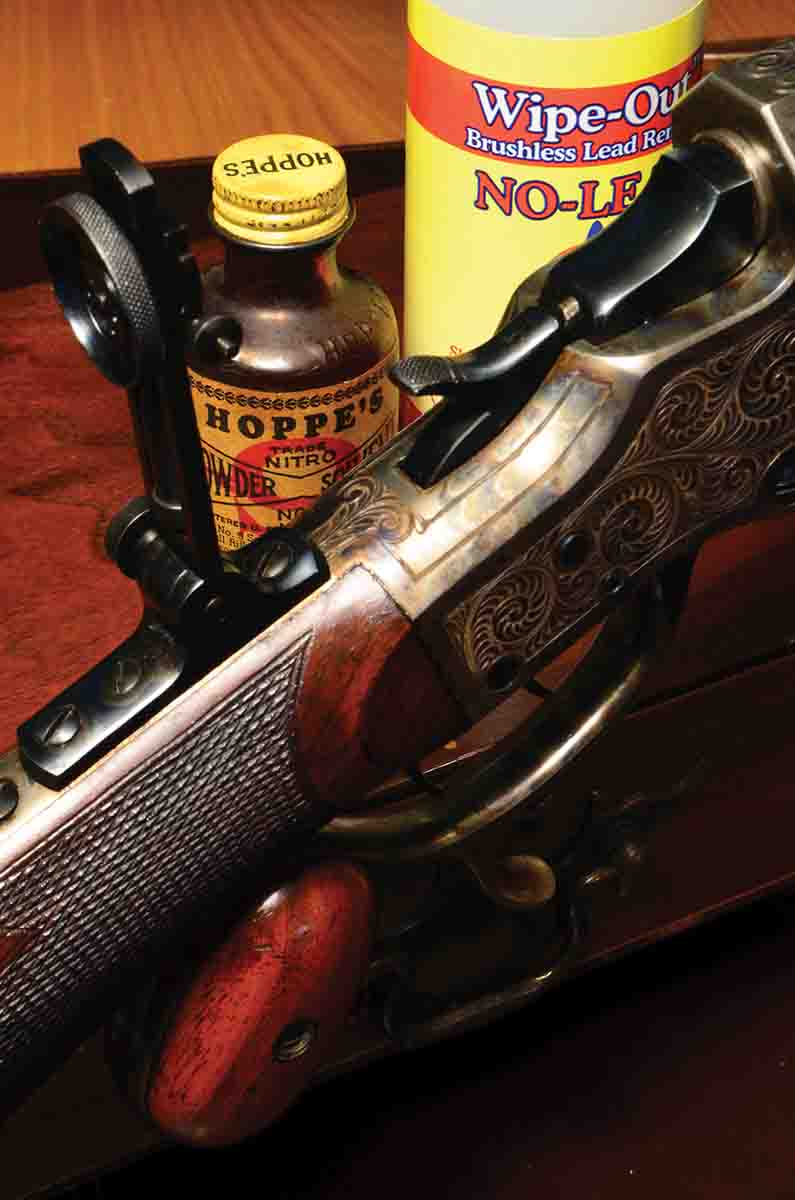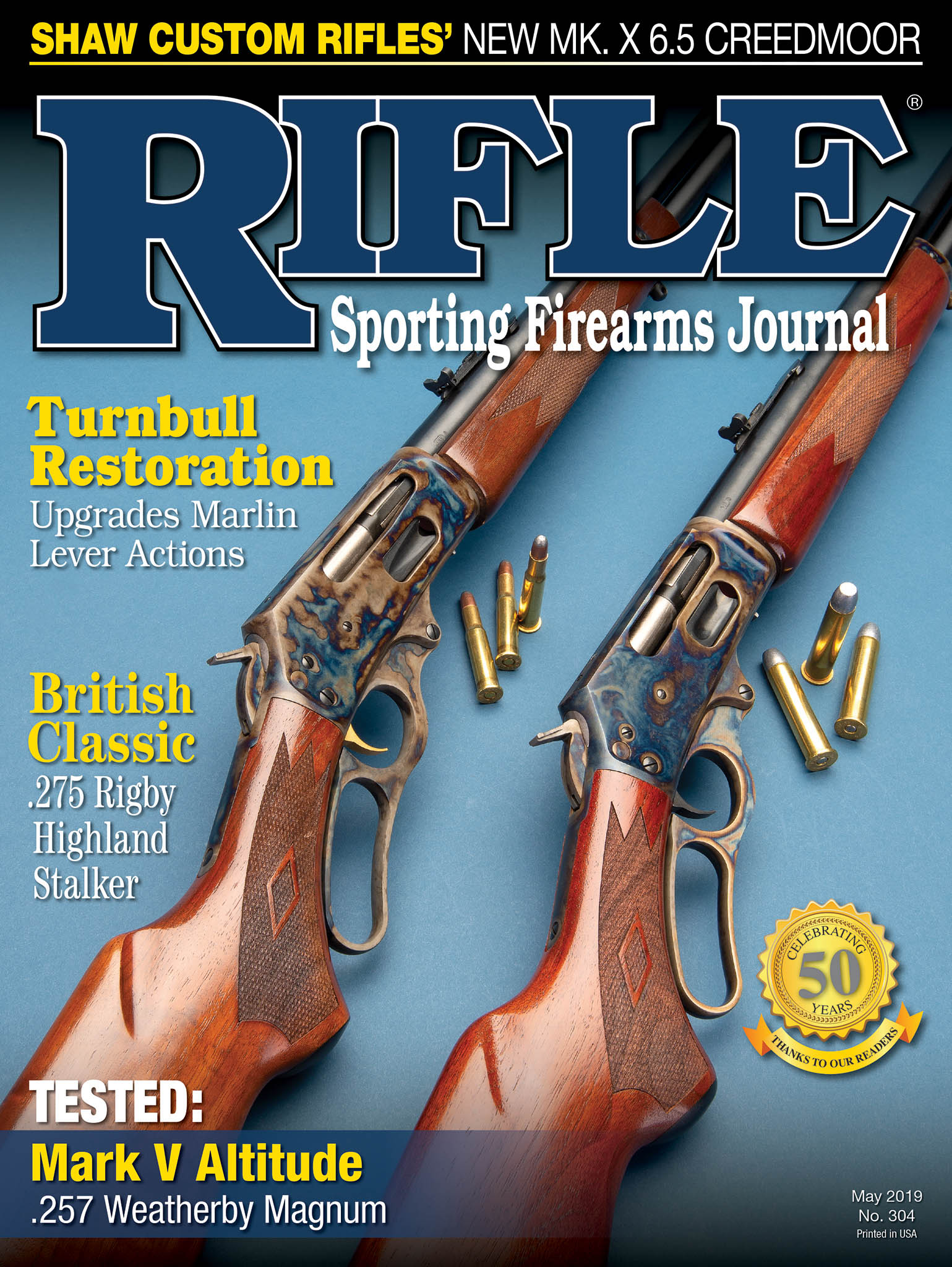Walnut Hill
Ghost of Cleaning Past
column By: Terry Wieland | May, 19
As one of those odd individuals who actually enjoys cleaning rifles, I tend to pay close attention to the appearance of patches when they come through the bore. Over the years, I have pretty much learned what to expect and how to interpret everything from “inky black” to “streaky blue.” Thus I was unprepared for what I saw when I began cleaning an old rifle that, outwardly, appeared to have nothing in the bore except normal smokeless powder fouling, and not much of that.

The bore of the .32-40 looked fine, with no traces of cuprous fouling at all. I suspect it has never had a jacketed bullet through it, and I intend to keep that record intact. However, I expected it had some lead fouling in the rifling, so I got out my bottle of Hoppe’s No. 9, ran an aromatic patch through it to get rid of powder residue and such, and then a dry patch. This was followed up with a regulation dose of Wipe-Out’s NO-LEAD lead-fouling remover. The rifle sat for 15 minutes, at which point I followed up with a dry patch.
What came out was like no patch I had ever seen. It appeared to be coated with red-brick dust mixed with oil – a deep reddish-brown oily goo. A second patch was only marginally better, and a third still carried traces of red. It was as if the rifle had an open wound.
Completely at a loss, I first consulted my resident-historian friend Garry James, who suggested it was residue of some preservative applied in the dim, distant past. I didn’t see how any preservative could have survived the two dozen shots I’d fired through it, but took it under advisement and turned next to Bob Hayley, who knows more about the technical intricacies of old rifles than anyone else I know.
The words were barely out of my mouth when he answered firmly, “Cosmic grease.”
“Cosmic what?”
“Grease. Back in the twenties, they had some stuff called ‘cosmic grease.’ It was a forerunner of Cosmoline. A long-term preservative.”
One would think that in almost 60 years of reading anything I can find related to guns, I would have heard of cosmic grease. Like most ex-military types, I am more than familiar with Cosmoline, which has made many a recruit’s life purgatory. But cosmic grease?
Bob told me it was a peculiar substance primarily intended to combat the effects of corrosive primers, but it was also a long-term treatment applied to any gun that was being put away for a while. The grease gradually hardened into a lacquer-like coating that not only forestalled rust, it resisted removal with the tenacity of a ship’s rat.
“Would it stay in the bore through 25 or 30 shots,” I asked? “Absolutely,” was the reply. The only way to get it out was chemistry. Apparently, Wipe-Out’s NO-LEAD is a good anti-cosmic treatment. This also explains the hard, red lumps of grease dug out of the action when it was apart, and which was removed only by a Varsol bath and a scrub brush.
The rifle, as mentioned, is a honey. Made in the period 1900 to 1902, it was probably ordered by a man who was not only well-to-do (the Model 51 was expensive) but also an experienced shooter who knew what odd features he wanted. One of those was an extra-heavy barrel. Bob suggested he didn’t shoot it much, looked after it carefully, and at some point applied a generous dose of cosmic grease, the universal gun preservative. The rifle was then put away, not to be fired from that day to this. That being the case, the rifle might not have been fired for close on 100 years, which accounts for its pristine bore and overall excellent condition.
Over the course of almost 60 years of rifle cleaning, I have used a wide variety of solvents, oils and miracle fouling removers. I will never be without Hoppe’s No. 9, simply because it makes the gun room smell so nice, and I have a lifetime supply of Ballistol, which is an excellent general-purpose oil. For getting cuprous fouling out of a bore, I have used Hoppe’s Benchrest 9 for more than 20 years. It doesn’t smell as nice as regular No. 9 (too much ammonia) and it removes cuprous fouling relatively slowly, but it doesn’t “eat” anything it should not and is not hostile to other surfaces. I have tried several super-aggressive ammonia formulae and find them simply too unpleasant to use. Gun cleaning is, to me, a pleasure, and they turn it into a task to be dreaded. As such, they don’t encourage cleaning when you should.
Various other so-called miracle “one application” solvents have never lived up to their billing. A couple of years ago, I tried Wipe-Out, a foam that fills the bore, removes fouling quickly and thoroughly and is not unpleasant to use. Wipe-Out deals with everything except lead. For that, the company makes NO-LEAD, which is a liquid applied with a patch in the usual manner.
I used NO-LEAD first on another newly acquired Stevens, this one a .25-20 Single Shot, and the patch came out covered with liquified lead that resembled putty – gray and gooey, but inoffensive. Hence my horror at the blood-stained patch that emerged from the .32-40 like the Red Badge of Courage.
A quick Google search for cosmic grease turned up several invitations to join various cults related to alien sightings, but also two references to rifles. One was in Col. Townsend Whelen’s book The American Rifle, published in 1918, wherein he gives instruction for everything from target shooting to rifle maintenance. The other was a 1927 guide written for the National Guard describing some of the same processes and, more important, how to get cosmic grease out of a rifle so it can be used. Their solution was a bath in kerosene followed by careful drying and re-lubricating every metal part.
Before anyone asks, let me say that my preferences for maintaining guns, and the regimens I follow for doing so, are both basic and traditional: For English guns, I like Hoppe’s No. 9, Rangoon Oil, Young’s 303 and the gunmaker’s traditional Vaseline mixed to different levels of viscosity with mineral oil; for everything else, it’s No. 9 plus Wipe-Out, NO-LEAD, occasionally J-B Compound if I’m feeling energetic and there are stubborn residual traces of fouling, and finally Ballistol as a cure-all lubricant and preventative. When grease is called for, I have the remains of a large tube of Nye Film 300T, a synthetic grease I’ve been using for more than 25 years. Obviously, it’s used sparingly. I also have some little tins of Blaser’s Waffenfett (weapon grease) which the company provides.
This list could probably be pared substantially, but my English guns insist on English cosmetics, the American guns would go on strike without Hoppe’s, and the German rifles – well, they demand Ballistol. Who am I to argue?
In a bizarre kind of way, I wish I could find some of that cosmic grease from a century ago, if only to embalm my guns before I shuffle off this mortal coil. For that matter, I may have myself embalmed in it. It would be better than a bronze coffin.


